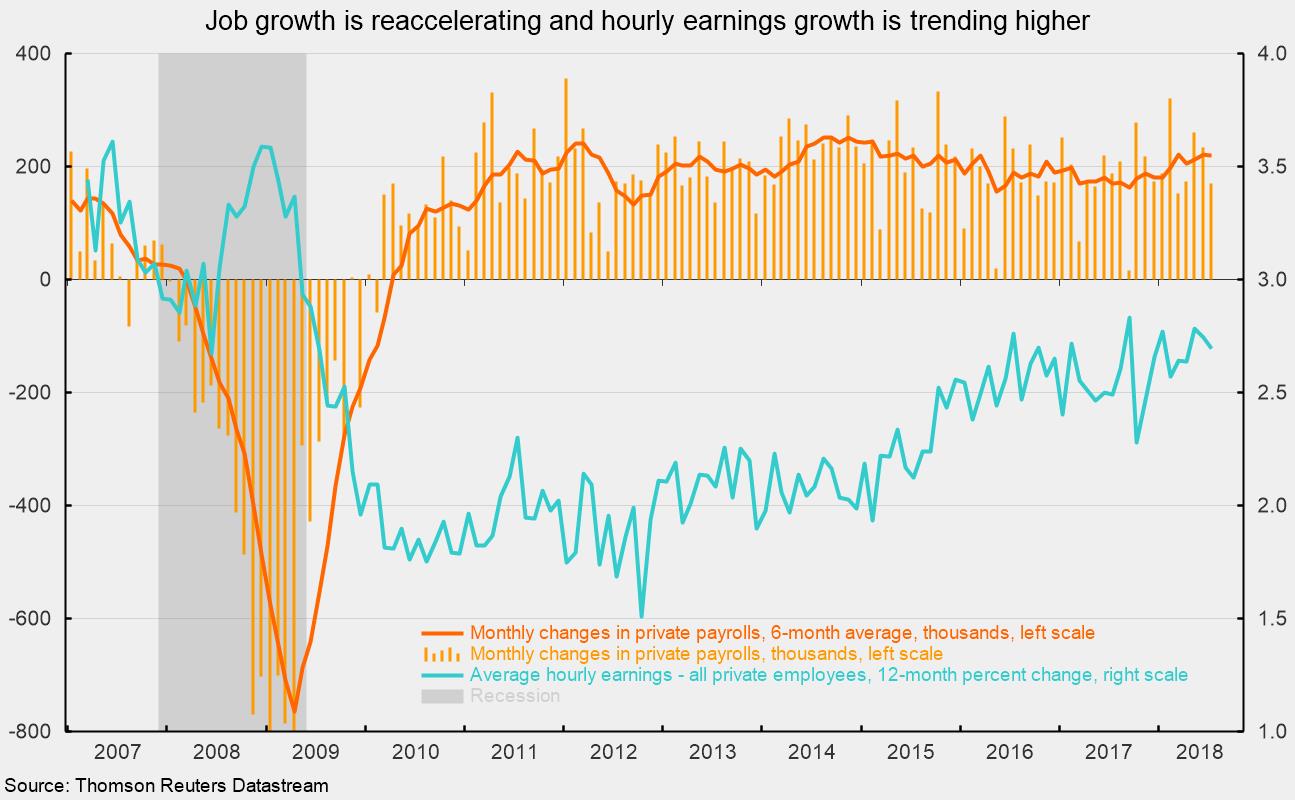Despite a Weak Headline, the July Jobs Report Is Upbeat
U.S. nonfarm payrolls added 157,000 jobs in July, below the consensus expectation of 190,000. However, the prior two months were revised upward by a combined 59,000, putting the June gain at 248,000 and the May increase at 268,000. Excluding the government sector, private payrolls added 170,000 in July following upwardly revised gains of 234,000 in June and 260,000 in May. Monthly payroll estimates tend to be somewhat volatile.
Job creation appears to have reaccelerated since private payrolls posted a very weak gain of just 16,000 new jobs in September 2017. Over the six months ending in September, private payrolls added an average of 162,000 per month, the second-slowest pace since 2012. Since September 2017, the six-month average has been trending higher, posting a 219,000 mark in July. Those gains have helped drive the unemployment rate down to 3.9 percent and boost wage growth to 2.7 percent (see chart). Though the pace of acceleration in wage growth has been slow by historical measures, the combination of increasing payrolls, accelerating wages, and a relatively long workweek has provided ample support for income growth, which in turn has helped support consumer confidence and consumer spending.
Within the 157,000 gain in jobs, goods-producing industries added 52,000 employees in July, slightly below the average gain of 57,000 over the past year. Durable-goods manufacturing and construction led with additions of 32,000 and 19,000 jobs, respectively. For private service-producing industries, which typically account for the lion’s share of job creation, payrolls added 118,000 workers, led by a 51,000 increase in professional and business services. Leisure and hospitality added 40,000 while the health care and social-assistance industries together added 34,000 jobs in July. Retail added 7,000 workers after a drop of 20,000 last month while financial services lost 5,000. The public sector shed 13,000 employees.
The unemployment rate fell 0.1 percentage points in July to 3.9 percent after ticking up to 4.0 percent in June on a surge of 601,000 entrants into the labor force. The labor force increased by an additional 105,000 in July, holding the participation rate steady in July at 62.9 percent. The participation rate remains well below the 66.0 percent rate that prevailed from 2004 through mid-2008.
Average hourly earnings rose 0.3 percent in July, resulting in a 12-month gain of 2.7 percent (see chart again). Gains in average hourly earnings have been below gains in previous cycles. The average length of the workweek decreased by 0.1 hours to 34.5 hours in July. Average weekly hours have been bouncing around between 34.3 and 34.6 hours since 2012.
Combining payrolls with hourly earnings and hours worked, the index of aggregate weekly payrolls rose 0.1 percent in July and is up 5.0 percent from a year ago. This aggregate measure has posted relatively steady year-over-year gains in the 3 to 5 percent range since 2010. In prior business cycles, this measure tended to be more cyclical, hitting growth rates in the 7 to 8 percent range but then collapsing. The slower and relatively steady gains in the current expansion may prove more beneficial as they may help sustain the economic expansion over a longer period compared to the faster, more cyclical gains of previous economic expansions.
Broad-based gains in the labor market are providing support for consumer confidence and consumer spending. The recently released initial estimate of second-quarter real gross domestic product shows a significant reacceleration in consumer spending from a very weak first quarter. Overall, the current economic expansion is maintaining solid momentum and the sources of growth are fairly broad.
Though pressures on prices remain, they are moderate enough that it is unlikely the Federal Open Market Committee will retreat from its path of normalization. At the moment, the likely action by the committee will be to implement a total of four quarter-point rate increases in 2018 (with two already implemented). The 10-year Treasury note yield has already risen to just under 3 percent from less than 1.5 percent in 2016. Rising short-term rates, solid growth, and moderate price pressures are likely to push longer term rates even higher in coming quarters. Rising federal deficits may exacerbate the upward pressure on bond yields.
The preponderance of economic data suggests continued economic expansion over the coming months and quarters and increases the probability that the current expansion will remain on track. However, the fallout from trade wars and the potential for higher long-term interest rates remain significant concerns.






